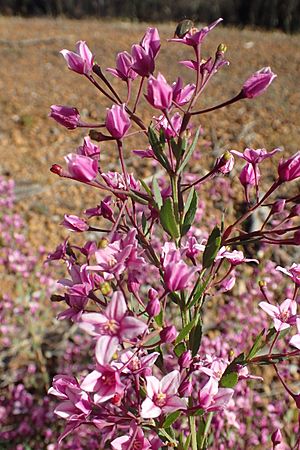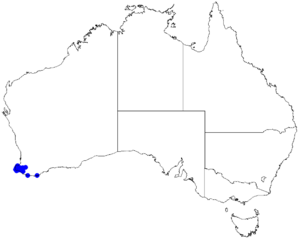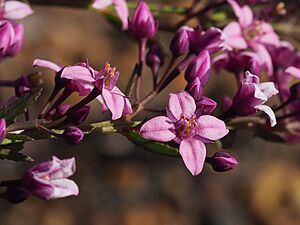Boronia tenuior facts for kids
Quick facts for kids Boronia tenuior |
|
|---|---|
 |
|
| Boronia tenuior growing near the Brockman Highway | |
| Conservation status | |
| Scientific classification | |
 |
|
| Occurrence data from Australasian Virtual Herbarium | |
| Synonyms | |
|
Boronia tenuior is a special kind of flowering plant. It grows only in Western Australia. This plant is a type of open shrub. It has thin, square stems. Its leaves are simple and have jagged edges. The flowers are usually pink or mauve. They have four petals.
Contents
What Does Boronia tenuior Look Like?
Boronia tenuior is an open shrub. It usually grows to be about 1 to 2 meters (3 to 6 feet) tall. It has smooth branches. These branches are mostly square shaped. They have a narrow, wavy, sticky edge on each corner.
The plant has simple, oval-shaped leaves. They are about 10 to 20 millimeters (0.4 to 0.8 inches) long. Their edges look like tiny saw teeth.
The flowers grow in groups called cymes. These groups are found at the ends of the branches. Big, red leaf-like parts called bracts are at the bottom of the flower groups. Each flower on the edge of the group sits on a thin, dark red stem. This stem is called a pedicel. It is about 7 to 20 millimeters (0.3 to 0.8 inches) long.
The plant has four dark red sepals. Sepals are small, leaf-like parts that protect the flower bud. They are narrow and shaped like a triangle or an egg. They are about 2.5 millimeters (0.1 inches) long. The four petals are pink to mauve. They are darker in the middle. Each petal is about 6 millimeters (0.24 inches) long. There are eight stamens. Stamens are the parts of the flower that make pollen. They have a bumpy tip and are hairy. Boronia tenuior mainly blooms from October to January.
How Did Boronia tenuior Get Its Name?
The plant Boronia tenuior was first officially described in 1923. A scientist named Karel Domin wrote about it. He used plant samples collected by Arthur Algernon Dorrien-Smith. The description was published in a science journal.
The second part of its name, tenuior, comes from a Latin word. Tenuis means "thin." This name likely refers to the plant's thin stems.
Where Does Boronia tenuior Live?
This type of boronia plant grows in specific places. You can find it near swamps and along streams. It also grows along roads and in areas that get wet during certain seasons. These places are found between the towns of Busselton, Augusta, Nannup, and Walpole in Western Australia.
Is Boronia tenuior Safe?
The Western Australian Government's Department of Parks and Wildlife has looked at Boronia tenuior. They have classified it as "not threatened." This means the plant is not currently in danger of disappearing.



